Coronary Artery Disease
Heart disease is common. Minor
congenital abnormalities affect one hundred live births and more serious
abnormalities approximately one in five hundred. Heart disease has two
peculiarities when compared with disease of other organs. First, it is very
commonly latent, that is a disease process of for example, the coronary arteries
can proceed to an advanced stage before the patient notices any symptoms.
Second, the number of symptoms attributable to heart disease is limited and it
is common for many different pathologies through a final common symptomatic
pathway.
SYMPTOMS OF HEART DISEASE

Breathlessness (Dyspnoea)
Breathlessness or dyspnoea is a
common symptom of cardiac disease. It is commonly defined as a subjective
awareness of increased work in breathing, but the mechanisms responsible for
this sensation are incompletely understood and may differ according to the
circumstances.
-
Exertional dysponea.
This is breathlessness which comes on during exertion exertion and subsides
on resting. It is commonly due either to heart failure or to lung disease. Some
patients with angina describe breathlessness rather than chest pain on exertion.
-
Pulmonary Oedema.
This is persistent breathlessness resulting from fluid accumulation in the lung
as a manifestation of acute left heart failure. The patients looks and feels
unwell, and there is peripheral vasoconstriction and tachycardia. Breathing is
rapid and shallow, and there is a persistent cough. Sputum is white and frothy,
sometimes tinged with pink. Crepitations are heard on auscultation of the chest,
initially at the lung bases, later throughout the lungs. Orthopnoea and
paroxysmal nocturnal dyspnoea are transient forms of pulmonary oedema.
Chest Pain
-
Angina. This is a
choking or constricting chest pain which comes on with exertion, is relieved by
rest, and is due to myocardial ischaemia. It is commonly felt retrosternally and
may radiate to the left or more rarely the right arm to the throat, jaws and
teeth, or through to the back. The pain may be squeezing, crushing, burning or
aching, but seldom stabbing. The pain may be brought on or exacerbated by
emotion, and is frequently made worse by large meals or a cold wind. It is
relieved by nitrates.
-
Myocardial infarction.
The pain is similar in nature and distribution to angina but is more severe,
persists at rest, and does not respond to nitrates. There are usually features
of sympathetic nervous system activation, and vomiting is common. There may be
anxiety and a feeling of impending death.
Types and differential
diagnoses of chest pain are summarized below.
Oedema
-
Peripheral oedema.
This
is a feature of chronic heart failure and is due to excessive salt and water
retention. In ambulant or sedentary patients it usually affects the ankles,
legs, thighs and lowers abdomen in that order. In a patient who is lying down it
is most apparent over the sacrum. The oedema of heart failure is usually
accompanied by some other symptoms of heart failure, and by a raised jugular
venous pressure. Unless it is long-standing and the skin is very tense the
oedema pits easily on pressure.
-
Oedema of chronic venous
insufficiency. This together with immobility is very common in the elderly.
It usually affects the ankles and lower legs only. The oedema pits readily and
redistributes after a night's sleep. However there are no other features of
cardiac failure. Oedema is a relatively late and unreliable feature of deep
venous thrombosis. However ilio-femoral vein thrombosis can cause severe venous
congestion and oedema.
Palpitation
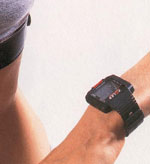 Palpitation is an abnormal
subjective awareness of the heart beat. Patients can usually distinguish between
sporadic and continuous palpitation (for example extrasystoles or a sustained
Tachycardia) and between an irregular and a regular
pulse. It may be helpful to
ask the patient to tap out the heart rhythm on the table. Palpitation with a
regular rhythm and a normal heart rate may be due to sudden vasodilatation (e.g.
during perimenopausal flushing). Palpitation is an abnormal
subjective awareness of the heart beat. Patients can usually distinguish between
sporadic and continuous palpitation (for example extrasystoles or a sustained
Tachycardia) and between an irregular and a regular
pulse. It may be helpful to
ask the patient to tap out the heart rhythm on the table. Palpitation with a
regular rhythm and a normal heart rate may be due to sudden vasodilatation (e.g.
during perimenopausal flushing).
Syncope
Syncope is loss of conciousness
resulting from an inadequate blood supply to the brain. This may be due to
sudden vasodilatation, to a sudden fall in cardiac output or to both
simultaneously. Postural syncope when due to vasodilator or antihypertensive
drugs is an example of the former, and diminished cardiac output from complete
heart block or a very rapid tachycardia of the latter.
-
Vasovagal fainting. This
involves both a reflex cardiac slowing mediated by the vagus and sudden
withdrawal of peripheral sympathetic tone. It is a complex centrally mediated
reflex which tends to be initiated when pain or a powerful emotional stimulus is
inflicted against a background of intense sympathetic stimulation. A very
similar reflex can also be triggered by mechano-receptors from the endocardium
of the left ventricle. This accounts for the fainting reflex which occurs in
patients with pulmonary embolism or aortic stenosis .
Other
Symptoms
-
Tiredness is a common
complaint with severe heart failure and with ischaemic heart disease. Sometimes
it is the consequence of treatment rather than the disease itself, e.g.
beta-blockade or hypokalaemia from diuretics. In those with valvular disease
without heart failure it lead to a suspicion of infective endocarditis.
Coronary artery
disease
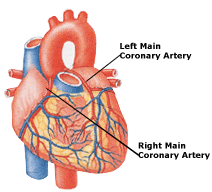
The coronary arteries are
branching blood vessels on the surface of the heart that supply the heart muscle
with the nutrient-rich blood it needs to function. If these arteries become
narrowed or blocked by the buildup of fatty deposits (plaque) in a process
called Atherosclerosis , the heart muscle does not get a sufficient
amount of oxygen and may be damaged. This condition called coronary artery
disease, can lead to a
heart attack.
How
does heart gets its own blood?
The heart is primarily a
mechanical muscle pump which contracts and pushes blood into the circulation to
supply oxygen and nourishment to all our body systems. It pumps blood into the
arterial blood channels of our body. The blood vessels are channels or tubes
that carry blood to and from all our organs such as the brain, kidneys, lungs,
heart muscle, skeletal muscles, stomach, intestines, skin , etc.
Its own quota of blood is
obtained through an exclusive set of arterial channels which originate from the
mouth of the arota. These special tubes travel the surface of heart as if
embracing it. These are shaped like a "corona" (crown), hence the name coronary
arteries. The pencil-sized coronary arteries originate from the principle
arterial trunk known as aorta. The main trunk aorta, of course, arises from the
left ventricle. There are three main coronary arteries and like the branch of a
tree, each main coronary artery divides and subdivides to transport oxygenated
blood to all cells of the heart muscle. The smallest branches often interlink
with one another and form what are known as collaterals.
Names of three principal
coronary arteries are:
-
Left anterior descending
artery
-
Left circumflex artery
On an average our heart beats
72 times per minutes.
Blood
Pressure Regulation
As blood flows from your heart
to your blood vessels, it pushes against the walls of your blood vessels. This
pressure is measured in millimeters of mercury (mmHg). The reading often is
recorded as two numbers�the pressure while the heart beats (systolic pressure)
over the pressure while the heart relaxes between beats (diastolic pressure).
The numbers are written one above or before the other. The systolic number comes
first, or on top, and the diastolic number comes second, or on the bottom.
What
is Atherosclerosis?
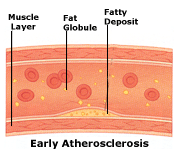 Atherosclerosis is the buildup
of fatty material called plaque on the inside walls of arteries. The formation
of plaque begins when a fatty substance called lipoprotein-made of cholesterol
and other fatty materials and protein-deposits itself on the inside walls of
arteries. This process stimulates abnormal growth of cells in the lining of the
arteries, which causes scarring and inflammation. The scarring and inflammation
damage the artery walls, leading to the formation of plaque. Over a lifetime, as
more and more fatty deposits accumulate, the size of the plaque grows,
potentially narrowing the artery or even blocking it completely. Blocking of an
artery can cut off the flow of Atherosclerosis is the buildup
of fatty material called plaque on the inside walls of arteries. The formation
of plaque begins when a fatty substance called lipoprotein-made of cholesterol
and other fatty materials and protein-deposits itself on the inside walls of
arteries. This process stimulates abnormal growth of cells in the lining of the
arteries, which causes scarring and inflammation. The scarring and inflammation
damage the artery walls, leading to the formation of plaque. Over a lifetime, as
more and more fatty deposits accumulate, the size of the plaque grows,
potentially narrowing the artery or even blocking it completely. Blocking of an
artery can cut off the flow of
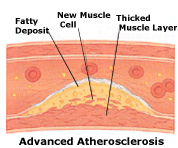 blood to vital organs, destroying those tissues.
If the blockage occurs in the arteries that nourish the heart, the result is
chest pain (angina ) or a heart attack . If the blockage cuts off the
flow of blood to the brain, the result is a
stroke . Blockages in blood
vessels in the legs can make walking painful. blood to vital organs, destroying those tissues.
If the blockage occurs in the arteries that nourish the heart, the result is
chest pain (angina ) or a heart attack . If the blockage cuts off the
flow of blood to the brain, the result is a
stroke . Blockages in blood
vessels in the legs can make walking painful.
FACTORS CONTRIBUTING TO A CORONARY ARTERY
disease
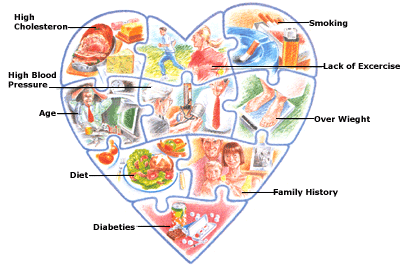 There are several factors that
can increase your risk of having a heart attack, some of which you can control.
You cannot control factors such as age or a family history of heart disease.
The four biggest risk factors for heart disease in women-high cholesterol
level, smoking,
high blood pressure, and
diabetes-are controllable. You can
do many relatively simple things to reduce your risk of heart disease, including
eating a
low-fat diet,
exercising regularly, not smoking, maintaining a
healthy weight, and getting treatment for high blood pressure or diabetes if
necessary. There are several factors that
can increase your risk of having a heart attack, some of which you can control.
You cannot control factors such as age or a family history of heart disease.
The four biggest risk factors for heart disease in women-high cholesterol
level, smoking,
high blood pressure, and
diabetes-are controllable. You can
do many relatively simple things to reduce your risk of heart disease, including
eating a
low-fat diet,
exercising regularly, not smoking, maintaining a
healthy weight, and getting treatment for high blood pressure or diabetes if
necessary.
-
High cholesterol level
High levels of cholesterol in the blood increase the likelihood that the
coronary arteries will become narrowed, which can lead to a heart attack. Before
menopause, the presence of the female hormone estrogen in the blood gives most
women lower total cholesterol levels than men and higher levels of the good,
heart-protecting cholesterol called high-density lipoprotein (H D L). However,
estrogen's heart-protecting advantage is lost after menopause, when the ovaries
reduce their production of hormone. The presence of estrogen in women's blood is
one reason they tend to develop heart disease later in life than men.
You can help maintain your cholesterol level in a healthy range by eating a
low-fat diet and getting regular exercise . If you have a high cholesterol
level and you already have heart disease, or you have other risk factors for
heart disease (such as high blood pressure), your doctor may recommend a
medication to lower your cholesterol level.
-
Smoking- Smoking
decreases the levels of two substances in the blood that help protect against
heart disease-HDL Cholesterol and the female hormone estrogen. Smoking as few as
one to four cigarettes a day doubles your risk of heart disease; smoking more
than a pack a day increases your risk up to 15 times.
Tobacco smoke contains small
quantities of carbon monoxide, which combines irreversibly with haemoglobin in
the red blood cells.
Normally haemoglobin carries out this function:
oxygen + haemoglobin
 oxy-haemoglobin
oxy-haemoglobin
However when carbon monoxide is inhaled, the following occurs:
carbon monoxide + haemoglobin
 carboxy-haemoglobin
carboxy-haemoglobin
Smoking also puts strain on
your heart because it causes blood vessels to constrict, which reduces the flow
of blood to your heart and makes the heart work harder to pump blood to other
parts of the body. In addition, toxic substances in cigarette smoke may directly
damage artery walls and cause Atherosclerosis, a process in which fatty
deposits accumulate on the inside of artery walls, potentially narrowing or
blocking the blood vessels. When you stop smoking, your risk of heart disease
drops rapidly.
Characteristic of Coronary artery disease in women
-
Presentation
Women present at a later age.
In women, typical angina is less predictive of coronary artery disease
(pretest probability is 50 to 60 percent in women versus 80 to 99 percent in
men).
Women may present with shoulder or jaw pain, dyspnea or nausea.
-
Risk factors
Diabetes has a stronger influence in women.
High HDL cholesterol levels, which lower the risk of coronary artery
disease, are more common in women.
The roles of total cholesterol, LDL cholesterol and lipoprotein(a) in women
are unclear.
The risk of coronary artery disease increases after menopause.
Diagnosing
Coronary artery Disease

If you experience angina or are
at high risk of heart disease, your primary care doctor may refer you to a
cardiologist, a doctor who specializes in disorders of the heart. To determine
the health of your heart, you may have one or more of the following tests. These
tests are listed in the order in which you are likely to have them, starting
with the test that is easiest to perform and the least invasive (does not
require entering your body or cutting into it).
-
Electrocardiogram
An
electrocardiogram (ECG but sometimes called an EKG) is a painless test that
records the flow of electricity through your heart. Electrodes attached to your
skin transmit this electrical activity to a machine that prints it out on a
recording that your doctor can read. Each beat your heart starts with an
electrical impulse. When there is an abnormality in your heart, the flow of
electricity through your heart changes. An ECG can help detect such a change. Your doctor can also use an ECG to help diagnose a wide range of heat
problems-including abnormal heart rhythms, abnormal thickening of the heart
muscles, defects in electrical impulses through the heart and damage to heart
tissues resulting from heart disease. However this test sometimes fails to
detect the presence of heart disease, especially if it has not caused any damage
to the heart muscle.
If the ECG reveals irregular
heart rhythms, your doctor may want to monitor your heart rate over a 24-hour
period using a portable ECG machine called a Holter monitor. The Holter monitor
is a device that is about the size of a portable cassette tape player. The
monitor is attached to a shoulder strap. Electrodes attached to the skin of your
chest transmit your heartbeat to a cassette tape inside the monitor, which is
later interpreted by your doctor. You wear the monitor continuously for 1 day
while you follow your usual routine. Your doctor may also recommend using the
Holter monitor for 24 hours if you have been experiencing chest pain, dizziness,
fainting episodes, or heart palpitations (sudden, rapid heartbeats).
The monitor can detect periods
of ischemia, which occur when the oxygen supply to the heart is temporarily
decreased. These episodes of ischemia may cause no symptoms and are then called
"silent" episodes because you are unaware of them. However, with or without
symptoms, these periods of ischemia may put you at increased risk of having a
heart attack. Ischemia usually indicates that your heart needs more oxygen than
your arteries are able to supply, usually because of a blockage caused by Atherosclerosis. If you are experiencing episodes of ischemia, your doctor
may prescribe medication to reduce their occurrence or recommend further testing
to evaluate the severity of your condition and help determine treatment.
-
Exercise stress test An
exercise stress test is an ECG that is taken while you walk on a treadmill or
ride a stationary bicycle. The purpose of this test is to determine whether your
heart is getting enough oxygen during exertion, when it requires more oxygen
than usual. Electronic sensors are attached to your body and connected to an ECG
machine. You begin exercising, slowly at first and then more quickly, until you
reach a
target heart rate.
Your target heart rate is
expressed in a number of beats per minute that is determined by your age and
physical condition. Your doctor will monitor your blood pressure at the same
time. An exercise stress test does not usually detect a problem unless one or
more coronary arteries are more than 50-percent blocked. The signs of
significant narrowing in a coronary artery include intolerable fatigue or chest
pain while exercising or an irregular hear rhythm detected on the ECG. In this
case, further testing, such as Angiography , is necessary to determine
the location and extent of the blockage.
UNDERSTANDING HEART
ATTACK
When a blood clot blocks a
coronary artery, the heart muscle is deprived of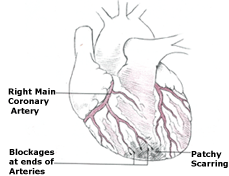 oxygen. The result is a heart
attack. Part of the heart muscle may die or become damaged; sometimes the
heart fails altogether, causing death. A heart attack can be sudden, painful,
and easy to identify, or it can cause few or no symptoms and go entirely
undetected. A heart attack can feel different to different people. You may have
crushing pain, or a squeezing sensation in your chest that may spread to your
neck, jaw, arms, or down your back; or back. Women are less likely than men to
call for help when they are having a heart attack, possibly because they have
not been diagnosed with heart disease or they think that heart attacks only
happen to men. heart attacks in women are often mistaken for indigestion. oxygen. The result is a heart
attack. Part of the heart muscle may die or become damaged; sometimes the
heart fails altogether, causing death. A heart attack can be sudden, painful,
and easy to identify, or it can cause few or no symptoms and go entirely
undetected. A heart attack can feel different to different people. You may have
crushing pain, or a squeezing sensation in your chest that may spread to your
neck, jaw, arms, or down your back; or back. Women are less likely than men to
call for help when they are having a heart attack, possibly because they have
not been diagnosed with heart disease or they think that heart attacks only
happen to men. heart attacks in women are often mistaken for indigestion.
A heart attack-or, in medical
terms, myocardial infarction-occurs when the blood supply to an area of the
heart is severely reduced or cut off. The process begins when one of the
coronary arteries (the blood vessels that supply blood to the heart) becomes
narrowed by deposits of a fatty substance called plaque. The buildup of plaque
inside arteries is a process called atherosclerosis . A narrowed coronary artery
is then blocked further, sometimes completely, by an obstruction, usually a
blood clot that sticks to the plaque. The formation of a blood clot in an
area of an a artery in which plaque has built up is called a coronary
thrombosis. If the supply of oxygen-rich blood to the heart is severely
blocked and remains blocked for too long, the lack of oxygen causes irreversible
damage to the heart muscle. Extensive damage to the heart muscle is often fatal
because the heart can no longer continue to pump blood to the rest of the body.
If you are having a heart
attack, the faster you get help, the greater are your chances of surviving it.
eighty percent of people who do survive a heart attack can return to their
normal life, including work, within 3 months. The following facts show how
acting quickly can help save your life if you think you are having a heart
attack.
-
The longer you delay
treatment for a heart attack, the more severely your heart is likely to be
damaged.
-
Most people who die of a
heart attack do so within 2 hours of the onset of symptoms.
WARNING
SIGNS OF A HEART ATTACK |
Call your immediately if
you are experiencing any of the following symptoms:
-
Uncomfortable tightness
or pressure, fullness, or squeezing deep in your chest or across your
chest
-
Chest pain that spreads
to your neck, jaws, or down your back
-
|
TREATING
CORONARY ARTERY DISEASE
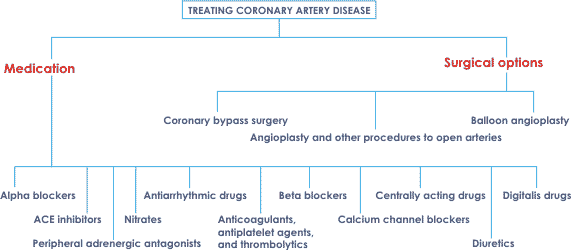
Minimizing all risk factors to
slow down atherosclerosis and prevent myocardial infarction (MI) is considered
important. Efficient secondary intervention usually includes ASA, beta-blocker,
statin and discontinuation of smoking
Besides, a woman who has a
heart attack is more likely than a man to die of it. This is partly because
women tend to be older than men when they have their first heart attack. Women
are also less likely to receive aggressive treatments, such as medication to
dissolve blood clots during a heart attack or surgery to open blocked arteries (angioplasty
) or to redirect blood flow from narrowed arteries (coronary bypass surgery
). Knowing the many effective treatments that are available for heart disease
can help you get the treatment you may need.
Medication
The array of drugs for treating heart
disease continues to grow. It often some adjusting to determine the right
combination of medications for a particular person. Your doctor may prescribe
different drugs alone or in combination to find what works best for you and
causes the fewest side effects. It is important to tell your doctor about any
side effects you are experiencing while you are taking any medication.
Heart disease medication fall
into the following major categories.
-
Alpha
blockers -Alpha blockers are drugs that help lower blood pressure by
preventing the blood vessels from constricting. These drugs also prevent
hormones your body releases in response to stress (such as adrenaline) from
raising your blood pressure. Alpha blockers are often combined with other drugs
to lower blood pressure. Alpha blockers sometimes cause dizziness.
-
ACE
inhibitors- ACE inhibitors (ACE stands for angiotensin-converting
enzyme) help lower blood pressure by blocking production of a hormone produced
by the kidneys called angiotensin II, which causes blood vessels to constrict.
These drugs are often used to control blood pressure in people with diabetes or
congestive heart failure . ACE inhibitors can cause a dry cough in some people.
Surgical
options
-
Angioplasty and other
procedures to open arteries A variety of procedures can be used to open a
narrowed or blocked artery. In some of these procedures, a tiny balloon (for
angioplasty) or cutting device (for atherectomy) attached to the end of a long,
thin tube (catheter) is inserted into the blocked artery to open it. In many
cases, these procedures to open an artery can replace coronary bypass surgery ,
which carries higher risks and has a longer recovery time. You may be a good
candidate for this type of procedure if you have a significant blockage in only
one or two of your arteries or if you have angina (chest pain) that cannot be
controlled with medication.
Before any of these procedures
to reopen blocked arteries you will be given a sedative to relax you and a local
anesthetic at the site at which the catheter enters your body-usually the skin
over the femoral artery in your groin or upper thigh. The cardiologist threads a
thin, flexible wire called a guide wire through this artery into your coronary
artery to a point just beyond the blockage. A catheter is then placed in the
coronary artery, and the size and location of the blockage is confirmed by
injecting dye through the catheter into the blocked artery to show its outline
on an X -ray.
-
In balloon angioplasty,
a catheter with a balloon at its tip is threaded into the artery, over the guide
wire, to the site of the blockage. A tiny balloon at he end of the catheter is
inflated at the blockage site, sometimes several times for 30 to 120 seconds
each time. The pressure of the balloon pushes the fatty buildup (plaque) back
against the artery walls and opens the artery to allow blood to flow more
freely. Balloon angioplasty is virtually painless, but you may feel some
pressure in your chest when the balloon is inflated. When the procedure is
finished, the doctor removes the catheter and balloon and performs another
angiogram to see if the artery has been opened successfully.




Cardiac rehabilitation
Cardiac rehabilitation is a
program of
-
Regular
exercise
-
Low-fat diet
-
-
Keep your
cholesterol level low to prevent plaque from building up in your arteries again.
A cardiac rehabilitation program can benefit anyone who has heart disease,
whether or not he or she has had a heart attack or any kind of heart surgery or
procedure. Ask your cardiologist for a recommendation regarding diet and
lifestyle modifications .
Although you can maintain an
exercise program and healthful diet on your own, it is far better to join an
organized program because you receive support from an experienced staff. Also,
you are with other people who are going through the same experience. The usual
rehabilitation process starts in the hospital a day or two after surgery with
simple activities such as moving to a bedside chair while an attendant makes the
bed. You are encouraged to gradually engage in more activity.
Quit smoking- Smoking should be discontinued and alcohol consumption
should be limited to moderate amounts.
Hypertension- should be treated optimally. The target level of below
140/90 mmHg should be reached.
Effective reduction of hyperlipidaemia is often possible only by using
statins. Target levels:
-
total cholesterol level below 5.0 mmol/L
-
Low-density lipoprotein (LDL) value below 3.0 (-2.5) mmol/L. Drug therapy
is indicated if low-density lipoprotein does not decrease to below 3.0 with
drugless therapy.
Treating obesity
-
Weight must be reduced to a target of
body mass index (BMI) 28.
-
Recognize metabolic syndrome and consider starting combination therapy
with a statin and fibrate
Physical exercise
-
Regular exercise improves the sense of well being and prognosis by
reducing many risk factors
-
On the basis of epidemiological studies,
hormone replacement therapy (HRT)
has been considered beneficial for women with risk factors. A randomized
secondary prevention study (Heart and Estrogen/Progestin Replacement Study)
did not, however, show any benefit from hormone replacement therapy .
A
heart-healthy lifestyle |
A
healthy lifestyle can greatly reduce your risk of heart disease.
Here are the most important things you can do to keep your heart
strong and working efficiently:
-
Eat
a
low-fat, low-cholesterol diet.
Saturated fats and cholesterol in foods can raise your
cholesterol level-a strong risk factor for heart disease.
-
Get
regular exercise. You are twice as likely to develop heart
disease if you are inactive than if you exercise regularly.
Exercise that increases your heart rate-such as brisk
walking,
swimming, or
weight lifting-lowers your blood pressure and cholesterol
level, and strengthens your heart so that it can pump more blood
with less effort.
-
-
Fish
is part of a heart-healthy diet. It contains omega-3 fatty
acids, which help improve blood cholesterol levels and prevent
blood clots.
-
 Eating plenty of fruits and vegetables is also encouraged.
Fruits
and vegetables contain antioxidants �
vitamins and
minerals that help prevent everyday wear and tear on your
coronary arteries. Eating plenty of fruits and vegetables is also encouraged.
Fruits
and vegetables contain antioxidants �
vitamins and
minerals that help prevent everyday wear and tear on your
coronary arteries.
-
|
Prevention of CAD:

How you live your life can greatly affect the health of your heart and your
coronary arteries. Taking the following steps can help you prevent coronary
artery disease, as well as a heart attack and congestive heart failure:
-
Get regular medical checkups. Some of the main risk factors for
coronary artery disease � high blood cholesterol, high blood pressure and
diabetes � have no symptoms in the early stages. Coronary artery disease
itself may produce no symptoms. But your doctor can perform tests to check
that you're free of these conditions. If a problem is found, you and your
doctor can manage it early to prevent complications.
-
Control your blood pressure. All adults should have their blood
pressure checked every 2 years. Your doctor may recommend more frequent
measurement if you have high blood pressure or a history of heart disease.
Dated 23 March 2012
Related article
|






 Palpitation is an abnormal
subjective awareness of the heart beat. Patients can usually distinguish between
sporadic and continuous palpitation (for example extrasystoles or a sustained
Tachycardia) and between an irregular and a regular
Palpitation is an abnormal
subjective awareness of the heart beat. Patients can usually distinguish between
sporadic and continuous palpitation (for example extrasystoles or a sustained
Tachycardia) and between an irregular and a regular

 Atherosclerosis is the buildup
of fatty material called plaque on the inside walls of arteries. The formation
of plaque begins when a fatty substance called lipoprotein-made of cholesterol
and other fatty materials and protein-deposits itself on the inside walls of
arteries. This process stimulates abnormal growth of cells in the lining of the
arteries, which causes scarring and inflammation. The scarring and inflammation
damage the artery walls, leading to the formation of plaque. Over a lifetime, as
more and more fatty deposits accumulate, the size of the plaque grows,
potentially narrowing the artery or even blocking it completely. Blocking of an
artery can cut off the flow of
Atherosclerosis is the buildup
of fatty material called plaque on the inside walls of arteries. The formation
of plaque begins when a fatty substance called lipoprotein-made of cholesterol
and other fatty materials and protein-deposits itself on the inside walls of
arteries. This process stimulates abnormal growth of cells in the lining of the
arteries, which causes scarring and inflammation. The scarring and inflammation
damage the artery walls, leading to the formation of plaque. Over a lifetime, as
more and more fatty deposits accumulate, the size of the plaque grows,
potentially narrowing the artery or even blocking it completely. Blocking of an
artery can cut off the flow of
 blood to vital organs, destroying those tissues.
If the blockage occurs in the arteries that nourish the heart, the result is
chest pain (angina ) or a heart attack . If the blockage cuts off the
flow of blood to the brain, the result is a
blood to vital organs, destroying those tissues.
If the blockage occurs in the arteries that nourish the heart, the result is
chest pain (angina ) or a heart attack . If the blockage cuts off the
flow of blood to the brain, the result is a
 There are several factors that
can increase your risk of having a heart attack, some of which you can control.
You cannot control factors such as age or a family history of heart disease.
The four biggest risk factors for heart disease in women-
There are several factors that
can increase your risk of having a heart attack, some of which you can control.
You cannot control factors such as age or a family history of heart disease.
The four biggest risk factors for heart disease in women-
 oxygen. The result is a heart
attack. Part of the heart muscle may die or become damaged; sometimes the
heart fails altogether, causing death. A heart attack can be sudden, painful,
and easy to identify, or it can cause few or no symptoms and go entirely
undetected. A heart attack can feel different to different people. You may have
crushing pain, or a squeezing sensation in your chest that may spread to your
neck, jaw, arms, or down your back; or back. Women are less likely than men to
call for help when they are having a heart attack, possibly because they have
not been diagnosed with heart disease or they think that heart attacks only
happen to men. heart attacks in women are often mistaken for indigestion.
oxygen. The result is a heart
attack. Part of the heart muscle may die or become damaged; sometimes the
heart fails altogether, causing death. A heart attack can be sudden, painful,
and easy to identify, or it can cause few or no symptoms and go entirely
undetected. A heart attack can feel different to different people. You may have
crushing pain, or a squeezing sensation in your chest that may spread to your
neck, jaw, arms, or down your back; or back. Women are less likely than men to
call for help when they are having a heart attack, possibly because they have
not been diagnosed with heart disease or they think that heart attacks only
happen to men. heart attacks in women are often mistaken for indigestion.





 Eating plenty of fruits and vegetables is also encouraged.
Eating plenty of fruits and vegetables is also encouraged.

